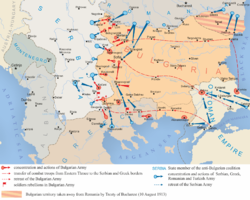
Back Tweede Balkanoorlog Afrikaans حرب البلقان الثانية Arabic Segunda guerra de los Balcanes AST İkinci Balkan müharibəsi Azerbaijani ایکینجی بالکان ساواشی AZB Икенсе Балҡан һуғышы Bashkir Другая балканская вайна Byelorussian Другая балканская вайна BE-TARASK Междусъюзническа война Bulgarian দ্বিতীয় বলকান যুদ্ধ Bengali/Bangla
| Second Balkan War | |||||||||
|---|---|---|---|---|---|---|---|---|---|
| Part of the Balkan Wars | |||||||||
 Map of the mainland operations of the Allied belligerents (amphibious actions not shown) | |||||||||
| |||||||||
| Belligerents | |||||||||
|
| |||||||||
| Commanders and leaders | |||||||||
| Strength | |||||||||
|
| |||||||||
| Casualties and losses | |||||||||
|
| ||||||||
The Second Balkan War (29 June[a] – 10 August 1913) was a conflict fought between Bulgaria and its former Balkan League allies, Serbia and Greece, who were later joined by Romania and the Ottoman Empire. The war began when Bulgaria, unhappy with the division of territory after the First Balkan War, launched attacks on Serbian and Greek forces, who repelled the offensive and pushed into Bulgarian territory. With most of Bulgaria’s army committed in the south, Romania intervened from the north.[10] The Ottoman Empire also took advantage of the situation to recover territories lost the previous year.
As Bulgaria suffered military setbacks on multiple fronts and Romanian forces advanced towards its capital, Sofia, it requested an armistice. The war ended with the Treaty of Bucharest, which compelled Bulgaria to cede significant territory: Southern Dobruja to Romania, parts of Macedonia to Serbia and Greece, and Adrianople (Edirne) to the Ottoman Empire under the separate Treaty of Constantinople.
The war altered the political balance in the Balkans and intensified regional tensions. Serbia expanded its territory and influence, heightening its rivalry with Austria-Hungary. Bulgaria, weakened by defeat and territorial losses, would later align with the Central Powers in the First World War.
- ^ a b "Bulgarian troops loses during the Balkan Wars". Archived from the original on 29 December 2011. Retrieved 12 January 2012.
- ^ a b c Hall 2000, p. 117
- ^ Erickson 2003, p. 323.
- ^ a b Hall 2000, p. 135
- ^ Leașu, Florin; Nemeț, Codruța; Borzan, Cristina; Rogozea, Liliana (2015). "A novel method to combat the cholera epidemic among the Romanian Army during the Balkan War – 1913". Acta medico-historica Adriatica. 13 (1): 159–170. PMID 26203545.
- ^ Ciupală, Alin (25 May 2020). "Epidemiile în istorie | O epidemie uitată. Holera, România și al Doilea Război Balcanic din 1913" (in Romanian). University of Bucharest.
- ^ Stoica, Vasile Leontin (2012). Serviciul Sanitar al Armatei Române în perioada 1914–1919 (PDF) (Thesis) (in Romanian). Chișinău: Ion Creangă State Pedagogical University. pp. 1–196.
- ^ Calculation (PDF) (in Greek), Hellenic Army General Staff, p. 12, archived (PDF) from the original on 7 June 2011, retrieved 14 January 2010.
- ^ Hall 2000, p. 119
- ^ Iordachi, Constantin (2017). "Diplomacy and the Making of a Geopolitical Question: The Romanian-Bulgarian Conflict over Dobrudja, 1878–1947". Entangled Histories of the Balkans. Vol. 4. Brill. pp. 291–393. ISBN 978-90-04-33781-7. p. 336:
the adjustment of the common frontier in Dobrudja had dominated diplomatic relations between Romania and Bulgaria ever since the aftermath of the Congress of Berlin (1878).
Cite error: There are <ref group=lower-alpha> tags or {{efn}} templates on this page, but the references will not show without a {{reflist|group=lower-alpha}} template or {{notelist}} template (see the help page).